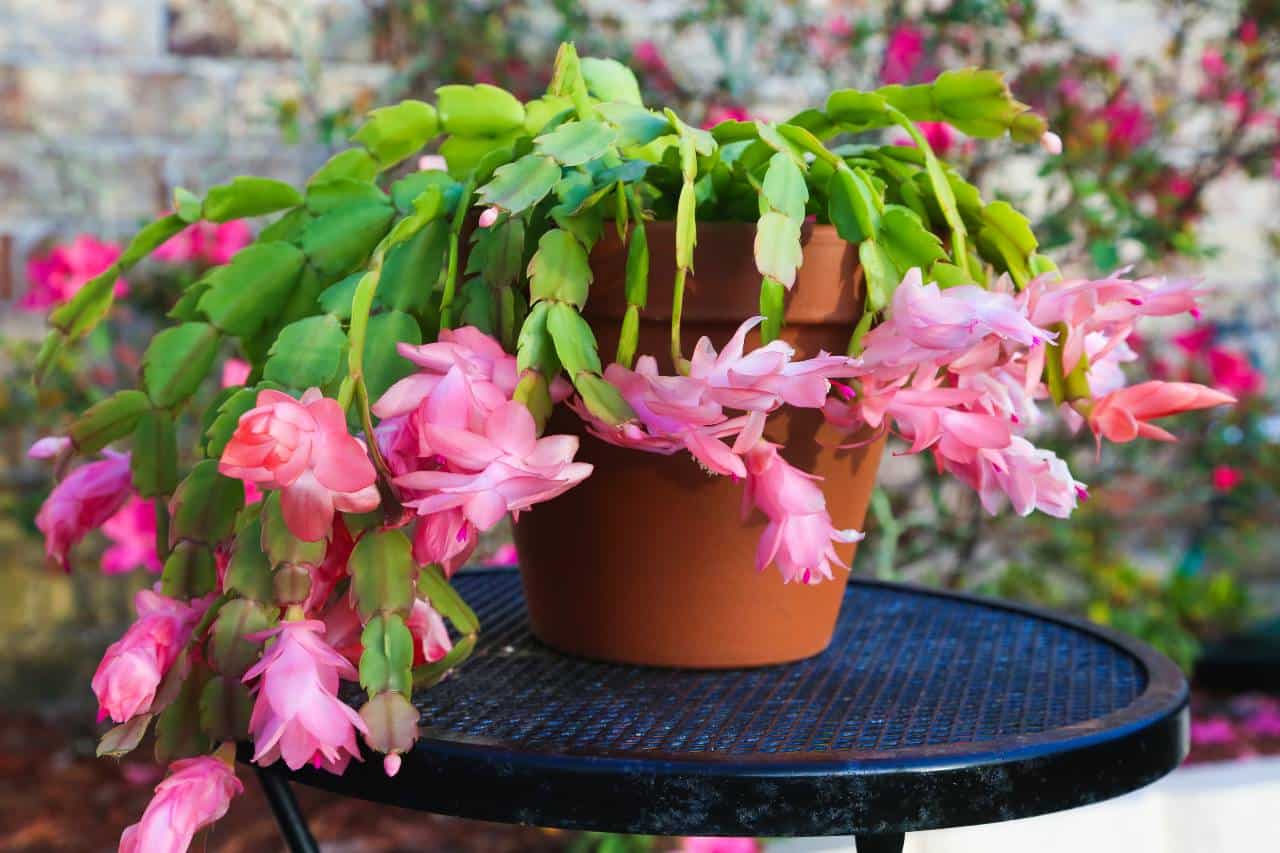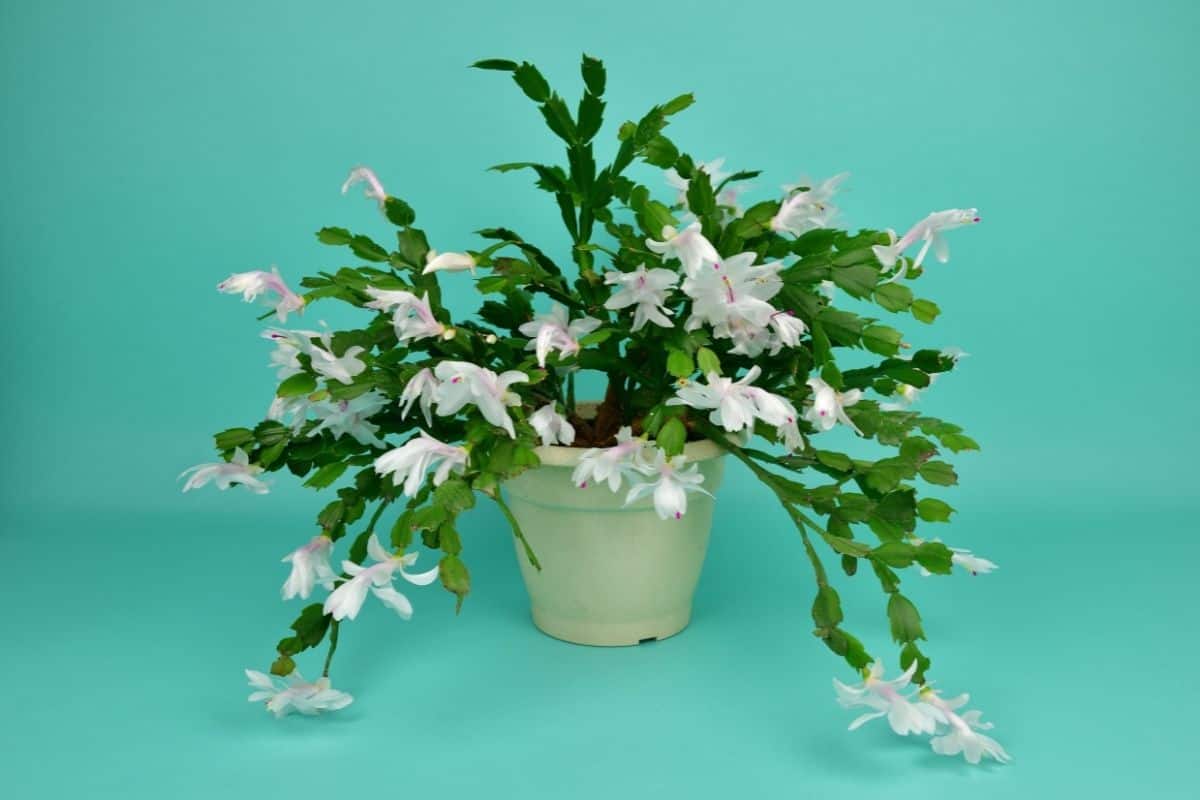
Are you struggling to get your Christmas cactus to bloom? The Christmas cactus is a very common houseplant that attracts growers due to its bright pink blowers and unusual shape.
Getting your Christmas cactus to bloom can be tricky, especially if you are living in an area that doesn’t have ideal weather conditions for the plant. If you are finding caring for your Christmas cactus challenging or disappointed in its performance during the blooming season, this article will help you.
Read through this post to learn how to get your Christmas cactus to bloom, along with some vital care and propagation tips. Enjoy!
Jump to:
Description
| Name: | Christmas Cactus |
| Soil: | Peat or well-decomposed compost |
| Blooming: | Early winter to mid-winter |
| Light: | Bright, indirect sun |
| Water: | Once the potting soil is dry to the touch |
| Propagation: | Stem cuttings |
The Christmas cactus is part of the schlumbergera genus native to the coastal mountains of eastern Brasil. There are about nine species of schlumbergera cacti, and their characteristics and ideal growing conditions are very different from their cacti and succulent cousins.
This plant grows on rocks and trees, and it looks more like a bunch of flowers when it is in bloom rather than a cactus. The Christmas cactus produces flat stems that stay very small regardless of the maturity of the plant. They bloom stunning cerise flowers during Christmas time in the Northern Hemisphere, which is how they got their name Christmas cactus.
Cultivars and Hybrids
There are lots of cultivars available that flower white, pink, orange, and bicolor. The majority of the Christmas cacti sold on the market are mainly Schlumbergera truncata hybrids.
Bloom Step-By-Step Guide
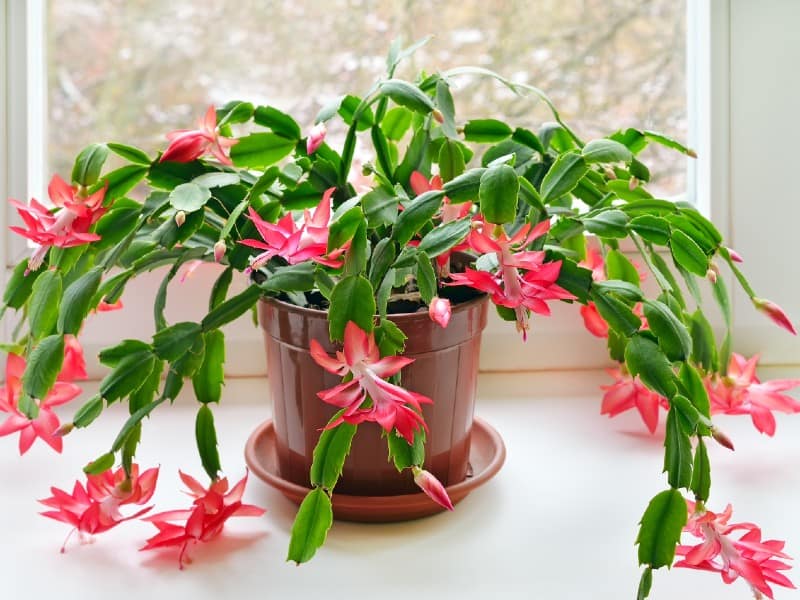
Buy it from:
The Christmas cactus needs a cold environment and a short day cycle to bloom healthy plants. Flower buds will only begin to grow when there are at least eight days of long 16 hour nights with at least eight hours of light in a day.
You can force a Christmas cactus to bloom out of season by mimicking an environment similar to that found in the wild during the blooming season. Whether you want to boost its natural chances of blooming in the winter, or you fancy tricking it into blooming in the spring or summer, the tips and tricks in the guide below will help you do it successfully.
1.Adjust the Temperature in the Room
The Christmas cactus blooms in cool temperatures of between 50 to 55 degrees Fahrenheit. If you are creating an artificial environment indoors, this temperature might be hard to achieve without the help of air conditioners and other air cooling methods.
2. Create Artificial Darkness
Install blackout blinds, keep the curtains shut and do whatever you need to do to make the room pitch black for 12 to 16 hours during the nighttime and early morning.
3. Make Sure there are Eight Hours of Bright Indirect Light Every Day
Do not put the Christmas cactus in direct sunlight if you want it to bloom. It needs to be placed in soft indirect sunlight in order to produce flowers.
No products found.
4. Water the Plant When the First inch of Top Soil is Dry
Reducing your watering habits is vital when it comes to getting your Christmas cactus to bloom. Wait for the first inch of topsoil to dry out before watering the plant.
These growing conditions should be maintained for at least six to eight weeks before you can expect the plant to bloom. Do not alter the growing conditions until you see healthy flowers appearing for the best chances of success.
Christmas cactus plants are stubborn and, therefore, will not bloom unless their growing conditions are spot on. If you keep your plant in the right light and temperature conditions and in a cool environment, your Christmas cactus will bloom multiple times throughout the year.
General Care Guide
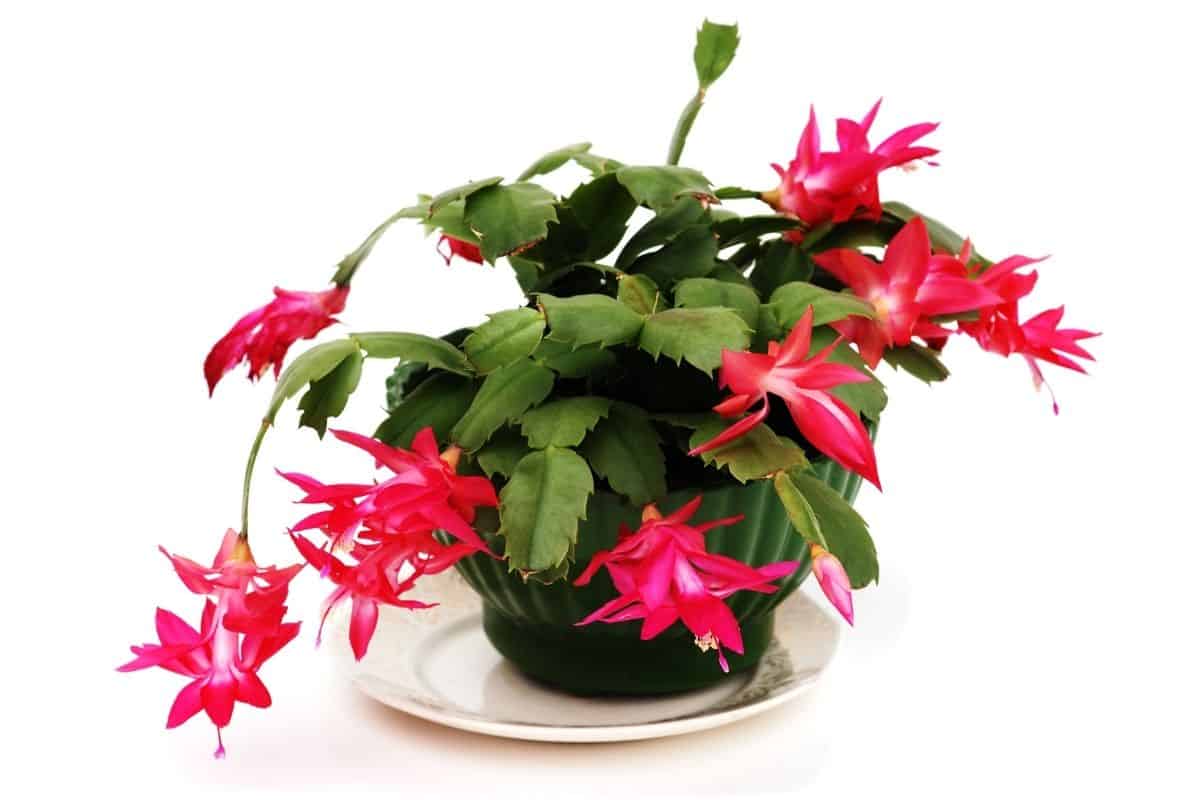
Don’t treat the Christmas cactus like you would any other cactus or succulent plant that you may have had in the past. This is a plant that thrives in cool, humid conditions and is a little bit more time-consuming to care for than other cactus species.
Light
Strong direct sunlight can be very damaging for Christmas cactus plants, so it is vital that you think properly about where you place your plant. Too much strong sunlight will stunt the plant’s growth and cause it to become sunburnt. Sunburnt parts of the plant will not repair themselves and will need to be removed in order for the plant to produce healthy stems and leaves.
The amount of sunlight that your plant will need will vary throughout the year. As a rule, Christmas cactus plants need at least 16 hours of total darkness every day during the blooming season. When your plant isn’t in bloom, it will need plenty of indirect sunlight to stay happy and healthy. Finding sunny spots in the house is far easier than finding indirect sunlight in the garden. Here are some suggestions and tips for growing the Christmas cactus both indoors and outdoors.
Indoor Christmas Cactus Plants
Indoor plants thrive in bright natural sunlight in your home. Sunrooms and sunny windowsills provide perfect lighting for Christmas cactus plants. If the windowsill is sun-facing, you should move it away from the window and into a bright area of the room.
Outdoor Christmas Cactus Plants
Christmas cactus plants that are situated on a balcony or in the garden are at higher risk of getting sun-damaged than indoor plants. Controlling the amount of sunlight that the plant gets is far easier to do when the plant is potted in individual pots rather than directly into the ground.
Place the Christmas cactus plants next to tall plants so that they shade the Christmas cactus from strong noon sunlight. Bring the plant indoors if you suspect that the plant is getting too much light.
Water
Unlight most cactus plants, the Christmas cactus needs thorough and frequent watering during the spring and summer months. If you live in an area of the world that is warm and dry, you will need to water your plant more frequently during winter too.
Your plant will begin to wilt if it isn’t getting enough water. Keeping up with a regular watering schedule will prevent this from happening so that your plant stays firm and solid.
Water your Christmas cactus when the top two inches of soil is dry. When the plant needs watering, you should water it from the base of the plant until it is soaked through.
Checking the moisture levels in the soil daily is a great habit to have when caring for Christmas cactus plants. Just like underwatering your plant can cause problems, so can overwatering it. It might take you a few weeks to get used to the plant’s water needs, but if you invest in a high-quality soil moisture detector, you will get the hang of it quickly.
Top Tip: Experienced plant growers won’t need to use a soil moisture kit to help them, but it will prevent unnecessary and costly care mistakes if you aren’t feeling confident in your watering abilities.
Temperature
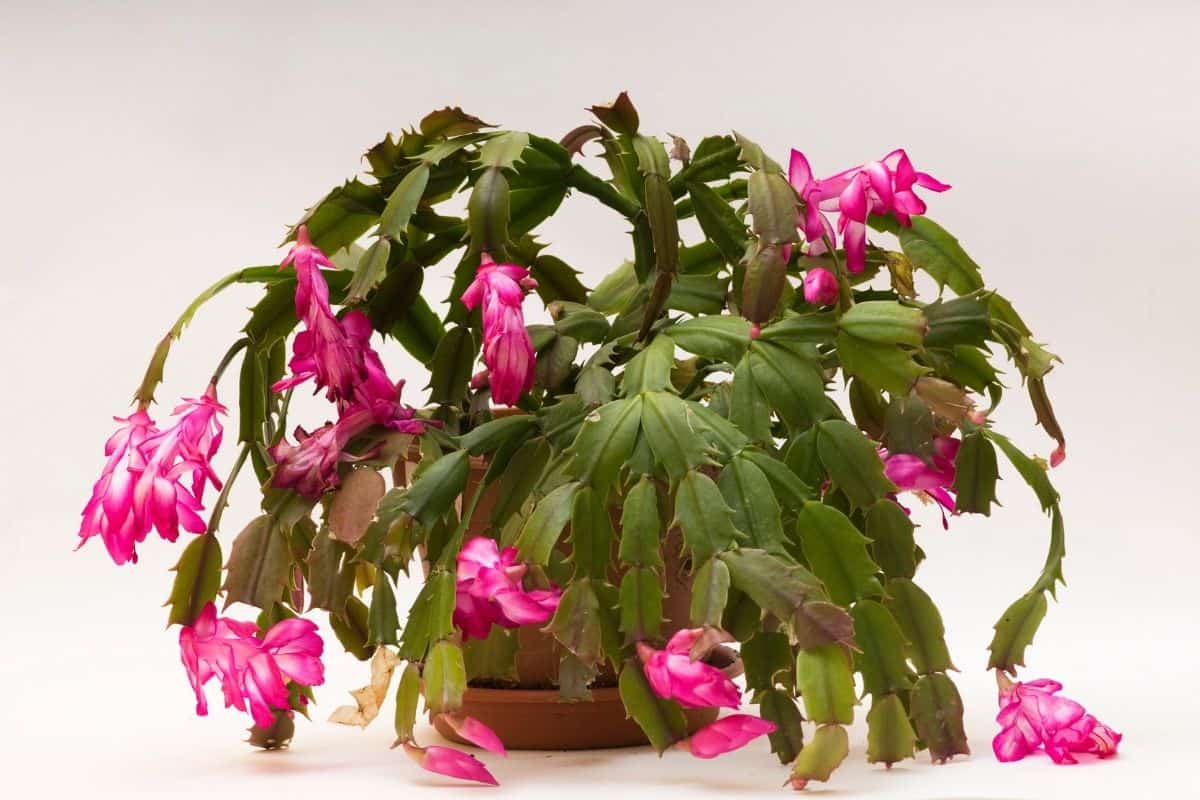
The Christmas cactus is a tropical plant, but it is not as heat tolerant as most cactus species, which is why you should keep it in an area where the temperature stays between 60 to 65 degrees Fahrenheit (15-18 C.).
Excess humidity is harmful to Christmas cactus plants, but light to moderate humidity is fine. If the air is particularly dry, you can add a pebble soil topper to the top layer of the plant. Water the plant until the water reaches the pebbles but does not cover them. As the water evaporates, the plant will receive a moisture boost.
Keeping outdoor plants outside during long hot summer days isn’t a good idea. Move your plant inside during heatwaves and long hot summer days to keep it safe from environmental damage.
Soil
Christmas cactus roots need plenty of room to breathe and grow, which is why planting them in well-aerated soil with great drainage is vital. You should never use regular potting soil for your Christmas cactus as it will retain too much moisture, suffocating the root system and resulting in poor blooming and stunted growth.
Propagation
Propagating the Christmas cactus is incredibly fun, easy, and rewarding. It is one of the best plants to propagate, and even hobbyist gardeners and people with very little gardening knowledge can propagate Christmas cactus plants with ease. Here is how to do it:
1.Gather Your Equipment
You will need clean gardening scissors or a clean, sharp knife, a plastic bag, porous succulent or cactus potting soil, fertilizer, and a container that is suitable for your cuttings.
2. Remove a Healthy Part of the Plant
Remove between five to seven healthy segments from the mother plant. Make sure you remove the segments at the base of the stem and try to get a clean and sharp cut.
3. Place the Segments in a Cool and Dry Place
Place the segments that you wish to propagate in a cool and dry location for a few days to allow them to dry out. You want the cut end of the segment to be completely dry before you replant it.
4. Plant in Potting Soil
Plant the segment in porous succulent or cactus potting soil, about one or two inches deep. You need to water the soil frequently to encourage new roots to form.
5. Place a Plastic Bag Over the Plant
If the air is dry, you can put a plastic bag over the propagated segments to create some humidity and natural moisture.
6. Keep the Plant in Bright Light
The newly propagated segments should stay in bright indirect sunlight.
Seeds
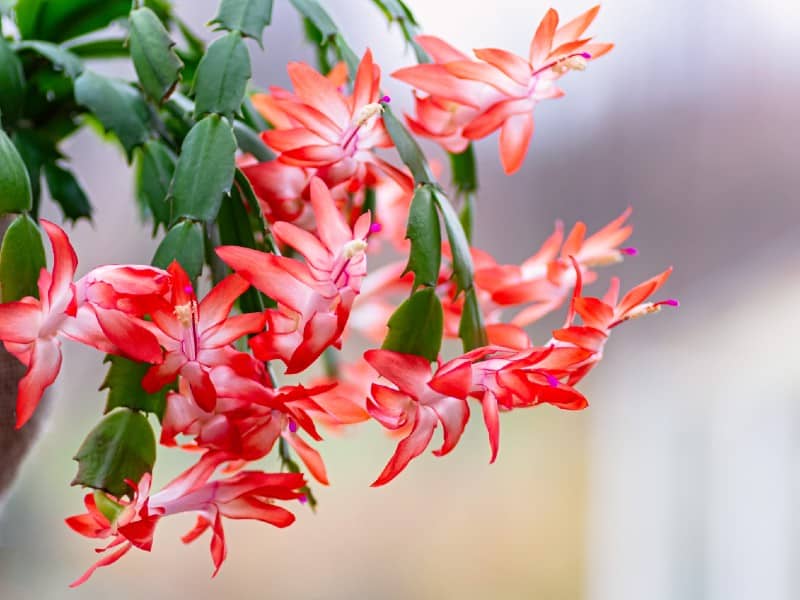
Christmas cactus seedlings take about two to three weeks to grow. The key is to keep the seeds and soil moist to encourage germination. Only attempt to grow Christmas cactus plants from seedlings when the temperatures are at the higher end of the ideal temperature range.
Offsets
Every stem growing from the Christmas cactus plant can be propagated, which is what makes the cactus so special. In order to do this successfully, you will need to follow the step-by-step guide in the section above to propagate your plant.
Common Pests and Problems
The Christmas cactus is more prone to pests and problems than most cactus species. Here is a list of the most common issues that Christmas cactus growers face and what to expect:
1. Aphids
These sap-sucking bugs are a real nightmare. They are very attracted to juicy plants that retain a lot of water. If you notice an aphid infestation, you will need to wash the plant in the sink and place a sticky trap at the bottom of the plant.
2. Fungus Gnats
Fungus gnats love deep and rich decaying matter. Picking up fallen leaves and flowers will prevent a fungus gnat infestation. Sticky traps will help catch adult flies, and keeping a well-maintained soil medium will prevent further infestation.
3. Root Rot
Root rot is caused by the plant being overwatered or planted into dense potting soil. Infected roots should be cut away along with any other damaged parts of the plant. It is also best practice to repot the plant into suitable porous potting soil.
4. Mealybugs
Mealybugs are able to travel easily from plant to plant, so as soon as you notice a mealybug infestation, you must move the infested plant away from others in your home or garden.
Wash the plant to remove the bugs and treat them with neem oil so that any remaining bugs will die. If neem oil doesn’t work, you might need to use a chemical insect treatment at the soil or base of the plant.
Indoor plants are less prone to pest infestations, but they can most certainly still occur, which is why you must inspect your plant regularly for signs of infestation or diseases. Untreated plants will not bloom, and you will also struggle to propagate them. When caught on time, most of the issues that Christmas cactus plants face are easily treated.
Sources:


